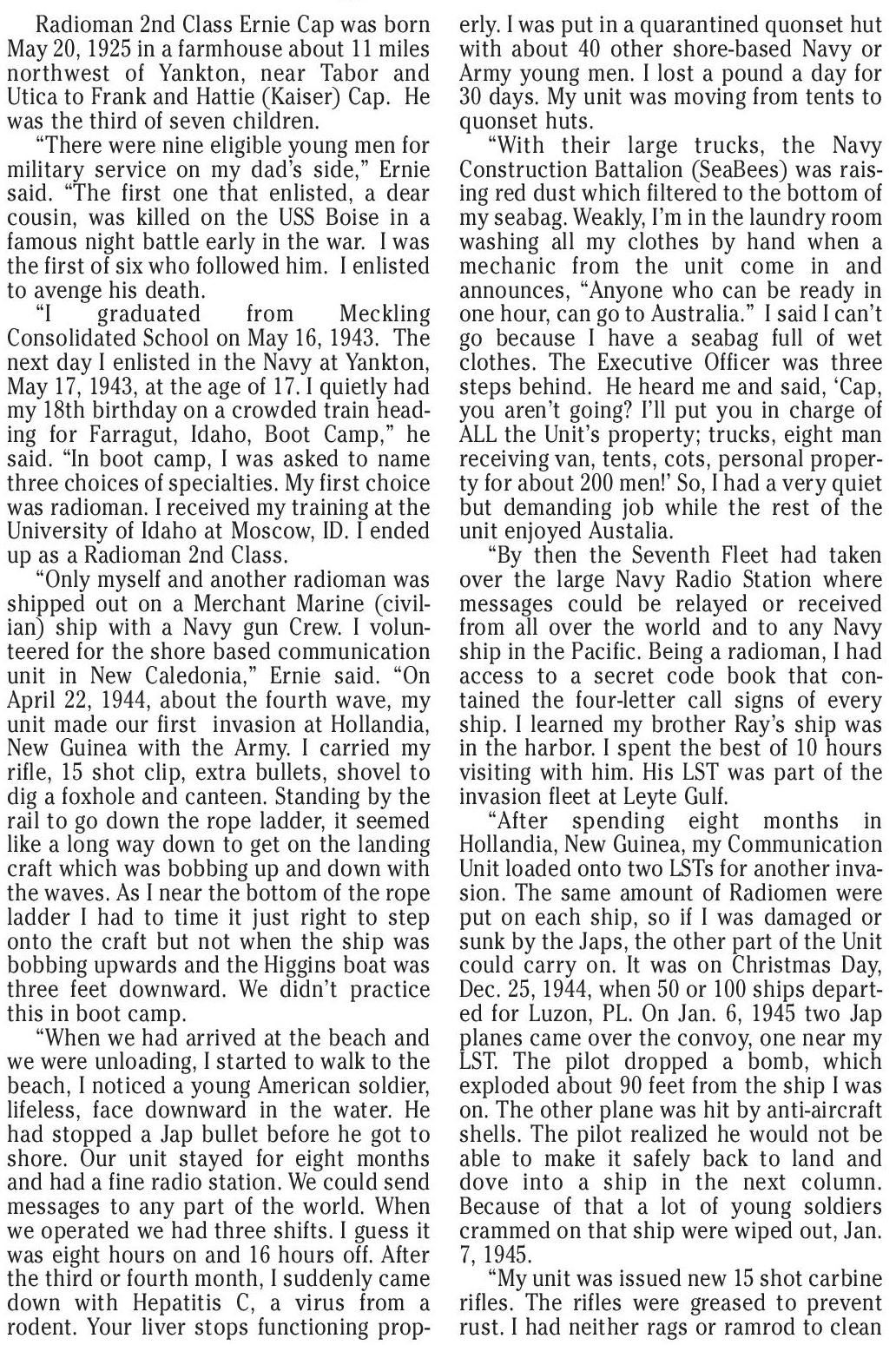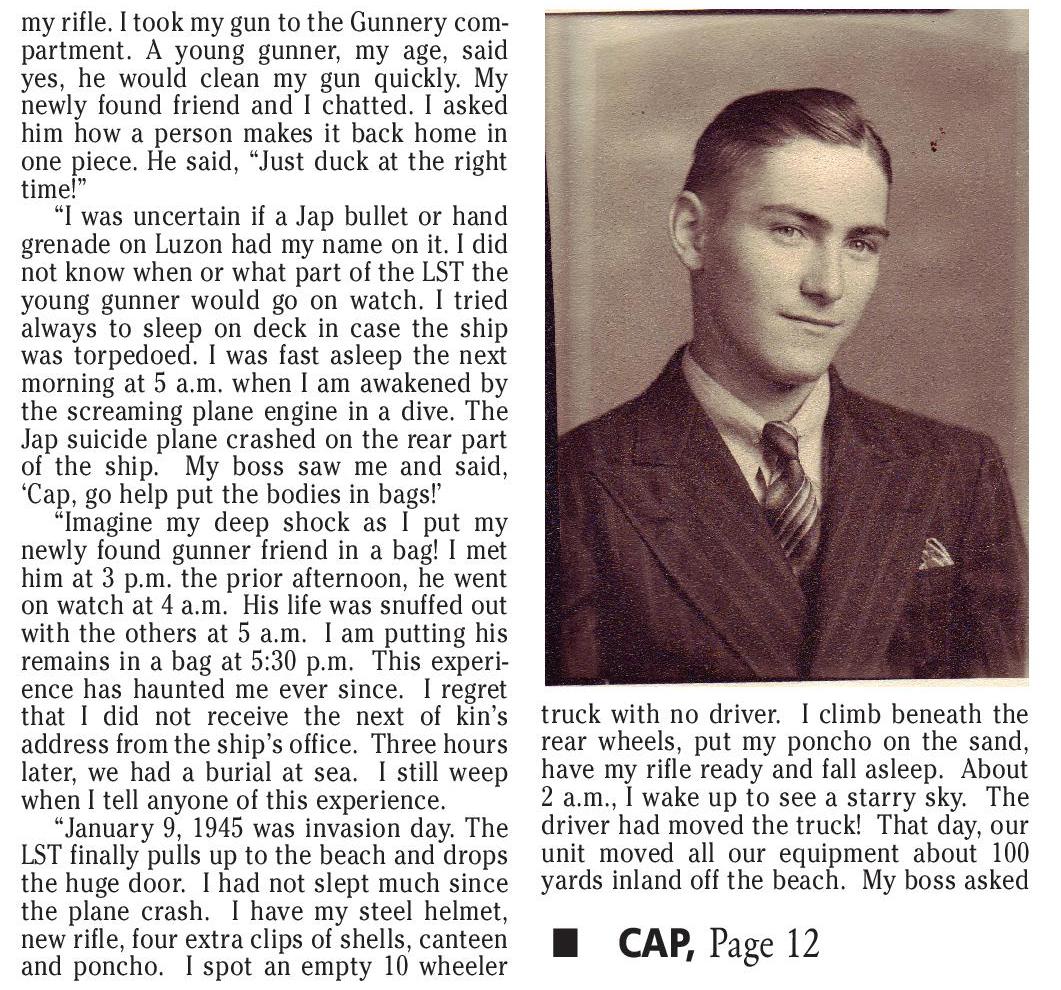11




November 9, 2012 www.plaintalk.net
Heritage 2012: Military 11
Honoring & Remembering – Ernie Cap
Radioman 2nd Class Ernie Cap was born
May 20, 1925 in a farmhouse about 11 miles
northwest of Yankton, near Tabor and
Utica to Frank and Hattie (Kaiser) Cap. He
was the third of seven children.
“There were nine eligible young men for
military service on my dad’s side,” Ernie
said. “The first one that enlisted, a dear
cousin, was killed on the USS Boise in a
famous night battle early in the war. I was
the first of six who followed him. I enlisted
to avenge his death.
“I
graduated
from
Meckling
Consolidated School on May 16, 1943. The
next day I enlisted in the Navy at Yankton,
May 17, 1943, at the age of 17. I quietly had
my 18th birthday on a crowded train heading for Farragut, Idaho, Boot Camp,” he
said. “In boot camp, I was asked to name
three choices of specialties. My first choice
was radioman. I received my training at the
University of Idaho at Moscow, ID. I ended
up as a Radioman 2nd Class.
“Only myself and another radioman was
shipped out on a Merchant Marine (civilian) ship with a Navy gun Crew. I volunteered for the shore based communication
unit in New Caledonia,” Ernie said. “On
April 22, 1944, about the fourth wave, my
unit made our first invasion at Hollandia,
New Guinea with the Army. I carried my
rifle, 15 shot clip, extra bullets, shovel to
dig a foxhole and canteen. Standing by the
rail to go down the rope ladder, it seemed
like a long way down to get on the landing
craft which was bobbing up and down with
the waves. As I near the bottom of the rope
ladder I had to time it just right to step
onto the craft but not when the ship was
bobbing upwards and the Higgins boat was
three feet downward. We didn’t practice
this in boot camp.
“When we had arrived at the beach and
we were unloading, I started to walk to the
beach, I noticed a young American soldier,
lifeless, face downward in the water. He
had stopped a Jap bullet before he got to
shore. Our unit stayed for eight months
and had a fine radio station. We could send
messages to any part of the world. When
we operated we had three shifts. I guess it
was eight hours on and 16 hours off. After
the third or fourth month, I suddenly came
down with Hepatitis C, a virus from a
rodent. Your liver stops functioning prop-
erly. I was put in a quarantined quonset hut
with about 40 other shore-based Navy or
Army young men. I lost a pound a day for
30 days. My unit was moving from tents to
quonset huts.
“With their large trucks, the Navy
Construction Battalion (SeaBees) was raising red dust which filtered to the bottom of
my seabag. Weakly, I’m in the laundry room
washing all my clothes by hand when a
mechanic from the unit come in and
announces, “Anyone who can be ready in
one hour, can go to Australia.” I said I can’t
go because I have a seabag full of wet
clothes. The Executive Officer was three
steps behind. He heard me and said, ‘Cap,
you aren’t going? I’ll put you in charge of
ALL the Unit’s property; trucks, eight man
receiving van, tents, cots, personal property for about 200 men!’ So, I had a very quiet
but demanding job while the rest of the
unit enjoyed Austalia.
“By then the Seventh Fleet had taken
over the large Navy Radio Station where
messages could be relayed or received
from all over the world and to any Navy
ship in the Pacific. Being a radioman, I had
access to a secret code book that contained the four-letter call signs of every
ship. I learned my brother Ray’s ship was
in the harbor. I spent the best of 10 hours
visiting with him. His LST was part of the
invasion fleet at Leyte Gulf.
“After spending eight months in
Hollandia, New Guinea, my Communication
Unit loaded onto two LSTs for another invasion. The same amount of Radiomen were
put on each ship, so if I was damaged or
sunk by the Japs, the other part of the Unit
could carry on. It was on Christmas Day,
Dec. 25, 1944, when 50 or 100 ships departed for Luzon, PL. On Jan. 6, 1945 two Jap
planes came over the convoy, one near my
LST. The pilot dropped a bomb, which
exploded about 90 feet from the ship I was
on. The other plane was hit by anti-aircraft
shells. The pilot realized he would not be
able to make it safely back to land and
dove into a ship in the next column.
Because of that a lot of young soldiers
crammed on that ship were wiped out, Jan.
7, 1945.
“My unit was issued new 15 shot carbine
rifles. The rifles were greased to prevent
rust. I had neither rags or ramrod to clean
Thank you to all the men &
women who have sacrificed to
protect our lives and freedoms.
my rifle. I took my gun to the Gunnery compartment. A young gunner, my age, said
yes, he would clean my gun quickly. My
newly found friend and I chatted. I asked
him how a person makes it back home in
one piece. He said, “Just duck at the right
time!”
“I was uncertain if a Jap bullet or hand
grenade on Luzon had my name on it. I did
not know when or what part of the LST the
young gunner would go on watch. I tried
always to sleep on deck in case the ship
was torpedoed. I was fast asleep the next
morning at 5 a.m. when I am awakened by
the screaming plane engine in a dive. The
Jap suicide plane crashed on the rear part
of the ship. My boss saw me and said,
‘Cap, go help put the bodies in bags!’
“Imagine my deep shock as I put my
newly found gunner friend in a bag! I met
him at 3 p.m. the prior afternoon, he went
on watch at 4 a.m. His life was snuffed out
with the others at 5 a.m. I am putting his
remains in a bag at 5:30 p.m. This experience has haunted me ever since. I regret
that I did not receive the next of kin’s
address from the ship’s office. Three hours
later, we had a burial at sea. I still weep
when I tell anyone of this experience.
“January 9, 1945 was invasion day. The
LST finally pulls up to the beach and drops
the huge door. I had not slept much since
the plane crash. I have my steel helmet,
new rifle, four extra clips of shells, canteen
and poncho. I spot an empty 10 wheeler
truck with no driver. I climb beneath the
rear wheels, put my poncho on the sand,
have my rifle ready and fall asleep. About
2 a.m., I wake up to see a starry sky. The
driver had moved the truck! That day, our
unit moved all our equipment about 100
yards inland off the beach. My boss asked
? CAP, Page 12
Dental Excellence for Children & Adults
Thank you to all the veterans for their
courage, sacrifice & service.
HERREN • SCHEMPP
BUILDING SUPPLY
www.herrenschempp.com
Locally Owned for the
Builder & Handyman!
• Home • Building Materials • Cabinets & Counters
• Windows & Doors • Siding & Roofing • Deck & Railing • Paint
1000 W. Cherry St., Vermillion, SD
1-888-624-2058 or 605-624-2058
Monday-Friday 7:30 a.m.-5:30 p.m.
Saturday 7:30 a.m.-5 p.m.
New Patients Welcome
Professional, Friendly & Caring Staff
HOURS:
Monday – Friday, 8:30 – 5:30
1714 East Cherry Street, Vermillion
•
605.624.6291
www.knutsonfamilydentistry.com

















 Previous Page
Previous Page






